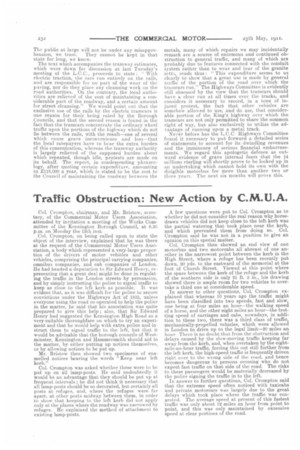Traffic Obstruction: New Action by C.M.U.A.
Page 2

If you've noticed an error in this article please click here to report it so we can fix it.
Col. Crompton, chairman, and Mr. Bristow, secretary, of the Commercial Motor Users Association, attended by invitation a meeting of the Works Committee of the Kensington Borough Council, at 8.30 p.m. on Monday the 15th inst. Col. Crompton, on being called upon to state the object of the interview, explained that he was there at the request of the Commercial Motor Users Association, a body which represented a very-large proportion of the drivers of motor vehicles and other vehicles, comprising the principal carrying companies, omnibus companies, and cab companies of London. He had headed a deputation to Sir Edward Henry, representing that a great deal might be done in regulating the traffic in the London streets by persuasion, and by simply instructing the police to signal traffic to keep as close to the left kerb as possible. It was evident that, as it was difficult for the police to secure convictions under the Highways Act of 1835, unless everyone using the road co-operated to help the police in the matter, he said that his association was quite prepared to give this help ; also, that Sir Edward Henry had suggested the Kensington High Road as a very-suitable thoroughfare on which to try an experiment and that he would help with extra police and instruct them to signal traffic to the left, but that it would be advisable that the borough councils of Westminster, Kensington and Hammersmith should aid in the matter, by either putting up notices themselves, or by allowing notices to be put up.
Mr. Bristow then showed two specimens of enamelled notices bearing the words "Keep near left kerb."
Col. Crompton was asked whether these were to be put up on all lamp-posts. He said undoubtedly it would be an advantage that they should be put up at frequent intervals ; he did not think it necessary that all lamp-posts should be so decorated, but certainly all posts at refuges, and, where the refuges were far apart, at other posts midway between them, in order to show that keeping to the left kerb did not apply only at the places where the roadway was narrowed by refuges. He explained the method of attachment to existing lamp-posts. A few questions were put to Col. Crompton as to whether he did not consider the real reason why horsedrawn vehicles did not keep close to the left kerb was the partial watering that took place near the kerb, and which prevented them from doing so. Col. Crompton said he was not in a position to give an opinion on this special matter. Col. Crompton then showed an end view of one motorbus and two motorcabs all abreast of one another in the narrowest point between the kerb in the High Street, where a refuge has been recently put down, 20 yds. to the eastward of the memorial at the foot of Church Street. Viewed at this point where the space between the kerb of the refuge and the kerb of the southern side is only 21 ft. 3 in., his drawing showed there is ample room for two vehicles to overtake a third one at considerable speed.
In answer to other questions, Col. Crompton explained that whereas 10 years ago the traffic might have been classified into two speeds, fast and slow, one being at four miles an hour—the walking speed of a horse, arid the other eight miles an hour—the trotting speed of carriages and cabs, nowadays, in addition to these two, there was a third class of traffic, mechanically-propelled vehicles, which were allowed in London to drive up to the legal limit-20 miles an hour. There is no doubt that from the obstruction and delays caused by the slow-moving traffic keeping far away from the kerb, and, when overtaken by the eightmile-an-hour traffic, forcing this out still further from the left kerb, the high-speed traffic is frequently driven right over to the wrong side of the road, and hence becomes dangerous to persons crossing who do not expect fast traffic on that side of the road. The risks to these passengers would be materially decreased by the police signing the traffic in to the left. In answer to further questions, Col. Crompton said that the extreme speed often noticed with taxicabs and private motorcars was largely due to the great delays which took place where the traffic was congested. The average speed at present of this fastest traffic was only about 12 miles an hour from point to point, and this was only maintained by excessive speed at clear portions of the road.






















